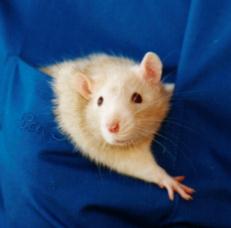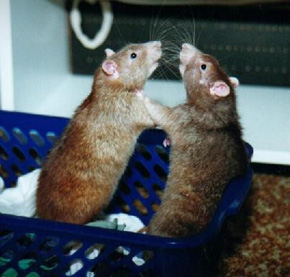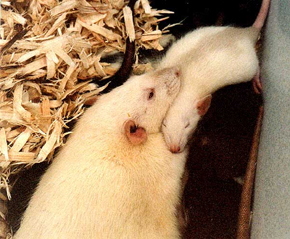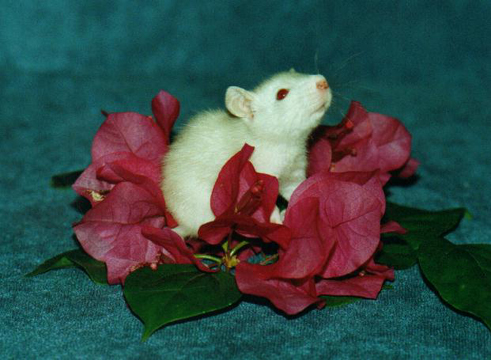

An argument in favor of pet ratsTable of Contents | ||||
Introduction | ||||
|
Do you have strong feelings about rats? Are those feelings negative, or are they positive? I hope to persuade you that rats make wonderful pets. I’ll be covering five main points; the first will be that rats are social animals and that they transfer their pack loyalties to their human companions. The second will be an examination of why some people find rats repulsive. The third will be to refute the widespread misconception that male rats eat baby rats. The fourth will be a description of how mother rats raise their young. And finally, the fifth will be how pet rats have been known to save their owner’s lives. | ||||
Rats are social animals | ||||
|
Rats are very much like dogs; they’re social animals and they transfer pack loyalty to their human companions. To recognize the significance of this transfer of loyalty, it is essential to understand that rats like other rats more than dogs like other dogs. I once had 27 rats in one cage; even though there was plenty of room to spread out, they all made a very large common nest and whenever they were at rest, they slept in one big pile. | ||||
| ||||
|
It is commonly agreed among members of the Internet listserv group Ratlist that rats need at least one companion of their own kind in order to be happy. However, I’ve observed that while a group of two rats isn’t miserable, a group of three is vastly more blissful. Having more than one rat won’t make them less interested in you, they’ll compete for your attention, because you’re the alpha and rats love their alphas. | ||||
Cultural biases against rats | ||||

Alphie pose two. Copyright © 2001 Valerie Jeanne. Used with permission.
But many people find rats repulsive. According to members of Ratlist, the most commonly voiced objection to pet rats is the appearance of their tails. A rat’s tail is almost hairless and has a scaly appearance. It has been repeatedly said on Ratlist that if rats had fluffy tails like squirrels, they’d be widely loved. Additionally, many people view rats as being carriers of disease, but the fact is that the diseases that rats are most prone to cannot be transmitted to humans. Rats are prone to pneumonia, which is a caused by a rat-specific species of a bacteria-like organism called mycoplasma; a human-specific species of mycoplasma causes pneumonia in humans. Fortunately, mycoplasma in rats can be treated with a combination of the antibiotics Baytril and Doxycycline. Rats are also susceptible to a potentially lethal rodent-specific virus called SDA. Although SDA itself is a virus, it weakens the immune system, which results in secondary bacterial infections. For this reason, rats that are sick with SDA require antibiotic therapy. As with flu, there is more than one strain of SDA, and some are more dangerous than others. 
Pocket pet. Copyright © 2002 Al & Robyn Arthur. Used with permission.
Fear and hatred of rats is peculiar to Western culture. Among Hindus and Buddhists rats are highly respected. Back when I had pet rats I would sometimes take a single one out on the town with me, stuffed into my jacket, snuggled against my stomach. Once I was in an Asian-American owned grocery store with a rat in my jacket, and while I was at the cash register he poked his head out of my jacket collar. The store owners were delighted to see him, and when I told them I had another 23 rats at home, they gave me 2 pounds of free cheese! | ||||
Males and babies | ||||
|
There is a widespread misconception that male rats eat baby rats. However, according to the Encyclopædia Britannica and the Encyclopedia Americana, among wild rats the entire colony loves everyone’s babies. I’ve observed this myself; I used to breed pet rats and I had three adult males who liked to cuddle with newborns. It is commonplace for a mother rat to cover her blind hairless babies with bedding if she leaves the nest to eat and drink. Once I saw an adult male approach a nest of unattended newborns that hadn’t been covered. He sniffed at them and a confused expression appeared on his face. He sat there thinking about what he seeing for a few moments, and then he pulled some bedding over the pinkies and walked away from the nest. | ||||
| ||||
|
It eventually became necessary to separate the boys and girls in order to limit population growth. Baby rats are weaned at the age of three weeks, and it is commonly agreed that baby boys should be separated from their mother and sisters by the age of five weeks. The problem with this is that baby rats benefit from having adult role models at least until they reach the age of six weeks. 
Ritualized behavior. Copyright © 2002 Al & Robyn Arthur. Used with permission.
Therefore, it was my practice to move the baby boys in with their father, grandfathers, and uncles when they reached the age of four weeks. This gave them two weeks with adult role models of their own gender. The adult males were always glad to see their young relatives. When the babies were around they were far more relaxed and abstained from engaging in their highly ritualized shoving matches. There was one breeding cycle where the father rat took more interest in the babies than all the other males combined. Baby rats tend to nest with each other, rather than dispersing into the group of adults. This father rat curled up around his sons whenever they were at rest and cuddling with each other. It broke his heart when most of them left for new homes at the age of six weeks. | ||||
Females and babies | ||||
|
Female rats have an extraordinarily strong maternal instinct. In my breeding colony it was commonplace for girls that hadn’t gotten pregnant to lactate anyway and help nurse the babies. Twice, girls who’d never been pregnant in their lives joined in nursing the babies. One of them hadn’t even reached puberty when she did so, yet she managed to lactate from one of her twelve nipples. I looked forward to breeding her, but she died before reaching childbearing age. One day back in 1998, my sister and infant niece came to visit. My grandmother alpha rat, Tara—who nursed almost every litter that came along—was fascinated with the baby. While Tara nursed her grandchildren, she stared with intent interest while my sister breast fed her human baby. Tara knew exactly what my niece and sister were doing, and it was a profound insight into human nature for her. Almost a year earlier, I saw Tara’s sister Millie—herself the mother of twelve-day-old babies—help Tara deliver her second litter. The birthing doe sat on her tailbone, legs spread; the midwife doe sat on her haunches, facing her. They took turns pulling alternate babies out of the womb, opening the amniotic sacks, and licking the newborns from head to toe. 
Alphie and her son Bunny. Copyright © 2001 Valerie Jeanne. Used with permission.
Unlike mother cats, mother rats never get cranky with their offspring and swat them in anger. The 1919 edition of the Encyclopædia Britannica makes note of this behavior, saying, “Rats demonstrate an extraordinary degree of forbearance with their young.” The author of the article was clearly dismayed; after all, this was in era when a common aphorism of child rearing was, “Spare the rod, spoil the child.” | ||||
Rats have been known to defend their owners | ||||
|
Rats have a reputation for being aggressive, but this is not necessarily a bad thing if you’re in need of protection. I read a newspaper report on the Internet that described an incident in which an occupied home had been broken into by two intruders who were holding the family at gunpoint. The family’s pet rat managed to escape from its cage and leapt onto one intruder’s face and sunk its razor sharp teeth deep into his nose. Then it dropped to the ground, climbed the second intruder’s pants leg, and sunk its teeth into his groin. This intervention enabled the family to grab the gun and hold the intruders at bay and on the spot until the police arrived. The police credited the rat with saving the family’s lives, as one of the intruders was already wanted for murder. I’ve also read of two separate incidents in which a rat escaped from its cage when a fire broke out in a house, and climbed a flight of stairs in order to scratch on its owner’s bedroom door, thus waking them up and saving their lives. | ||||
Conclusion | ||||

Bunny the baby dumbo stakes his claim. Copyright © 2001 Valerie Jeanne. Used with permission.
Those are my five main points. Most of what I’ve told you describes how rats relate to each other, but since your rat will transfer its pack loyalties to you, it will be this affectionate with you as well. Rats are just as endearing as more common pets, but they’re more loyal than cats, while being less needy than dogs. I hope that I have been able to persuade you that rats are actually adorable creatures, and that if you’re looking for a new pet it would benefit you to welcome two or three of these animals into your life. | ||||
|









